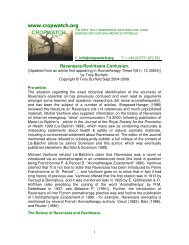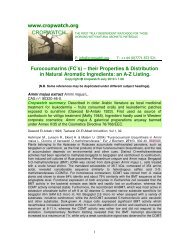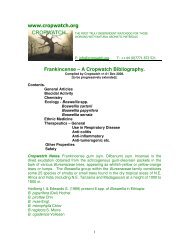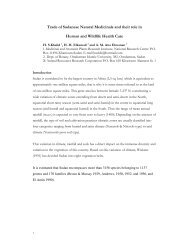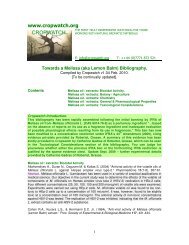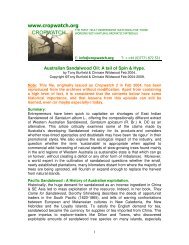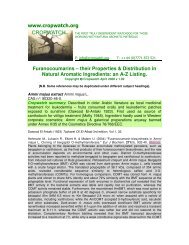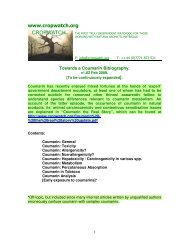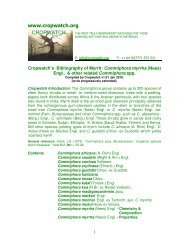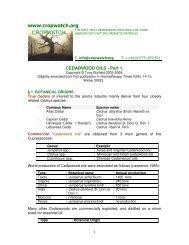Sandalwood Biblio - Cropwatch
Sandalwood Biblio - Cropwatch
Sandalwood Biblio - Cropwatch
Create successful ePaper yourself
Turn your PDF publications into a flip-book with our unique Google optimized e-Paper software.
Maslin B.R., Byrne M., Coates D., Broadhurst L. et al. (1999) "The Acacia acuminata (Jam)<br />
group: an analysis of variation to aid <strong>Sandalwood</strong> (Santalum spicatum) " Report to the<br />
<strong>Sandalwood</strong> Business Unit, Department of Environment & Conservation, Australia (1999).<br />
Misra U. (2009) "How India's <strong>Sandalwood</strong> Oil trade got hijacked." Business 6th Aug 2009.<br />
<strong>Cropwatch</strong> comments: The article comments on how India went from sandalwood oil exporter to<br />
importer, with a look at Australia's 20,000 ha sandalwood plantation profect. Tim Coakley,<br />
executive chairman of the Wescorp Group of Companies is quotes as estimating that 15 to 17<br />
tons/annum of oil of Santalum spicatum is currently produced in Australia and that exporting of oil<br />
of Santalum album would start in 3-7 years.<br />
Mullholland J. (1994) “An investigation of the harvesting processing and export of Western<br />
Australia sandalwood (Santalum spicatum).” - Abstract of Masters Thesis University of Australia;<br />
summary available at the website of Institute of Foresters of Australia<br />
http://www.ifa.unimelb.edu.au/abstracts/master/1994/mulholland1994.htm<br />
Murphy M.T., Garkakalis M.J. & Hardy G.E.S.J. (2005) “Seed catching by woylies Bettongia<br />
penicillata can increase sandalwood Santalum spicatum regeneration in Western Australia”<br />
Austral. Ecology 30(7), 747-755.<br />
Murphy M. & Mark Garkaklis M. (2003) "Hopping Into A Bright Future- The Woylie <strong>Sandalwood</strong><br />
Story." <strong>Sandalwood</strong> Research Newsletter 18.<br />
Murthy S.G. (1985) “<strong>Sandalwood</strong>: case study of a resource in decline.” Garden 16-19.<br />
Oates A. (1989) The Story of <strong>Sandalwood</strong> The Museum of the Golfields Kalgoorlie<br />
Owen L.N. (1949) "Lanceol, a sesquiterpene alcohol from the oil of Santalum lanceolatum. Part II.<br />
Some observations on the degradation product." J. Chem. Soc., 1949, 1582 - 1586,<br />
Possingham J. (1986) "Selection for abetter Quandong." Australian Horticulture February 1986<br />
pp55-59<br />
Radomiljac A. (2000) see: http://users.bigpond.net.au/sellwood/kimsoc/pasttalk00.htm<br />
Radomiljac A.M. (1998). “The influence of pot host species, seedling age and supplementary<br />
nursery nutrition on Santalum album (Linn.) plantation establishment within the Ord River<br />
Irrigation Area, Western Australia.” Forest Ecology and Management 102(2–3), 193–201.<br />
Abstract. A factorial experiment investigated the effect of six pot host species treatments<br />
(Alternanthera nana, Sesbania formosa, Atalaya hemiglauca, Acacia hemignosta, Crotalaria<br />
retusa and no pot host), two Santalum album seedling age treatments (24 and 17 weeks at field<br />
establishment) and a supplementary nursery nutrition treatment (2×100 ml 5% Ca Wuxal®) on<br />
Sa. album survival and growth 287 days after field establishment. Significant variation exists<br />
between pot host species in increasing Sa. album survival and growth. Al. nana and Se. formosa<br />
pot host species significantly increased Sa. album survival, height and diameter. Sa. album<br />
survival, height and diameter was significantly better with supplementary nursery nutrition. Sa.<br />
album survival and height was significantly greater and pot host species survival was significantly<br />
poorer with older Sa. album seedlings. Older seedlings and supplementary nursery nutrition gave<br />
higher levels of Sa. album field survival and growth when parasitised to poor pot host species but<br />
not when parasitised to satisfactory pot host species.<br />
Raychaudhuri S.P. & Varma A. (1980) “Sandal spike” Review of Plant Pathology 59(3), 99-107.<br />
Razikari H. (1996) “An assessment of the commercial potential of quandong (Santalum<br />
acuminatum) varieties in Broken Hill. Thesis, University of Western Sydney, Hawkesbury.<br />
RIRDC (undated) see: http://www.rirdc.gov.au/champions/MtRomanceAustralia.html.<br />
16





